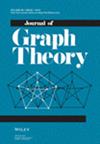求助PDF
{"title":"关于有限群的定向 m $m$ 半圆代表","authors":"Jia-Li Du, Yan-Quan Feng, Sejeong Bang","doi":"10.1002/jgt.23145","DOIUrl":null,"url":null,"abstract":"<p>A finite group <span></span><math>\n <semantics>\n <mrow>\n \n <mrow>\n <mi>G</mi>\n </mrow>\n </mrow>\n <annotation> $G$</annotation>\n </semantics></math> admits an <i>oriented regular representation</i> if there exists a Cayley digraph of <span></span><math>\n <semantics>\n <mrow>\n \n <mrow>\n <mi>G</mi>\n </mrow>\n </mrow>\n <annotation> $G$</annotation>\n </semantics></math> such that it has no digons and its automorphism group is isomorphic to <span></span><math>\n <semantics>\n <mrow>\n \n <mrow>\n <mi>G</mi>\n </mrow>\n </mrow>\n <annotation> $G$</annotation>\n </semantics></math>. Let <span></span><math>\n <semantics>\n <mrow>\n \n <mrow>\n <mi>m</mi>\n </mrow>\n </mrow>\n <annotation> $m$</annotation>\n </semantics></math> be a positive integer. In this paper, we extend the notion of oriented regular representations to oriented <span></span><math>\n <semantics>\n <mrow>\n \n <mrow>\n <mi>m</mi>\n </mrow>\n </mrow>\n <annotation> $m$</annotation>\n </semantics></math>-semiregular representations using <span></span><math>\n <semantics>\n <mrow>\n \n <mrow>\n <mi>m</mi>\n </mrow>\n </mrow>\n <annotation> $m$</annotation>\n </semantics></math>-Cayley digraphs. Given a finite group <span></span><math>\n <semantics>\n <mrow>\n \n <mrow>\n <mi>G</mi>\n </mrow>\n </mrow>\n <annotation> $G$</annotation>\n </semantics></math>, an <span></span><math>\n <semantics>\n <mrow>\n \n <mrow>\n <mi>m</mi>\n </mrow>\n </mrow>\n <annotation> $m$</annotation>\n </semantics></math>-<i>Cayley digraph</i> of <span></span><math>\n <semantics>\n <mrow>\n \n <mrow>\n <mi>G</mi>\n </mrow>\n </mrow>\n <annotation> $G$</annotation>\n </semantics></math> is a digraph that has a group of automorphisms isomorphic to <span></span><math>\n <semantics>\n <mrow>\n \n <mrow>\n <mi>G</mi>\n </mrow>\n </mrow>\n <annotation> $G$</annotation>\n </semantics></math> acting semiregularly on the vertex set with <span></span><math>\n <semantics>\n <mrow>\n \n <mrow>\n <mi>m</mi>\n </mrow>\n </mrow>\n <annotation> $m$</annotation>\n </semantics></math> orbits. We say that a finite group <span></span><math>\n <semantics>\n <mrow>\n \n <mrow>\n <mi>G</mi>\n </mrow>\n </mrow>\n <annotation> $G$</annotation>\n </semantics></math> admits an <i>oriented</i> <span></span><math>\n <semantics>\n <mrow>\n \n <mrow>\n <mi>m</mi>\n </mrow>\n </mrow>\n <annotation> $m$</annotation>\n </semantics></math>-<i>semiregular representation</i> (O<span></span><math>\n <semantics>\n <mrow>\n \n <mrow>\n <mi>m</mi>\n </mrow>\n </mrow>\n <annotation> $m$</annotation>\n </semantics></math>SR for short) if there exists an <span></span><math>\n <semantics>\n <mrow>\n \n <mrow>\n <mi>m</mi>\n </mrow>\n </mrow>\n <annotation> $m$</annotation>\n </semantics></math>-Cayley digraph <span></span><math>\n <semantics>\n <mrow>\n \n <mrow>\n <mi>Γ</mi>\n </mrow>\n </mrow>\n <annotation> ${\\rm{\\Gamma }}$</annotation>\n </semantics></math> of <span></span><math>\n <semantics>\n <mrow>\n \n <mrow>\n <mi>G</mi>\n </mrow>\n </mrow>\n <annotation> $G$</annotation>\n </semantics></math> such that it has no digons and <span></span><math>\n <semantics>\n <mrow>\n \n <mrow>\n <mi>G</mi>\n </mrow>\n </mrow>\n <annotation> $G$</annotation>\n </semantics></math> is isomorphic to its automorphism group. Moreover, if <span></span><math>\n <semantics>\n <mrow>\n \n <mrow>\n <mi>Γ</mi>\n </mrow>\n </mrow>\n <annotation> ${\\rm{\\Gamma }}$</annotation>\n </semantics></math> is regular, that is, each vertex has the same in- and out-valency, we say <span></span><math>\n <semantics>\n <mrow>\n \n <mrow>\n <mi>Γ</mi>\n </mrow>\n </mrow>\n <annotation> ${\\rm{\\Gamma }}$</annotation>\n </semantics></math> is a <i>regular oriented</i> <span></span><math>\n <semantics>\n <mrow>\n \n <mrow>\n <mi>m</mi>\n </mrow>\n </mrow>\n <annotation> $m$</annotation>\n </semantics></math>-<i>semiregular representation</i> (regular O<span></span><math>\n <semantics>\n <mrow>\n \n <mrow>\n <mi>m</mi>\n </mrow>\n </mrow>\n <annotation> $m$</annotation>\n </semantics></math>SR for short) of <span></span><math>\n <semantics>\n <mrow>\n \n <mrow>\n <mi>G</mi>\n </mrow>\n </mrow>\n <annotation> $G$</annotation>\n </semantics></math>. In this paper, we classify finite groups admitting a regular O<span></span><math>\n <semantics>\n <mrow>\n \n <mrow>\n <mi>m</mi>\n </mrow>\n </mrow>\n <annotation> $m$</annotation>\n </semantics></math>SR or an O<span></span><math>\n <semantics>\n <mrow>\n \n <mrow>\n <mi>m</mi>\n </mrow>\n </mrow>\n <annotation> $m$</annotation>\n </semantics></math>SR for each positive integer <span></span><math>\n <semantics>\n <mrow>\n \n <mrow>\n <mi>m</mi>\n </mrow>\n </mrow>\n <annotation> $m$</annotation>\n </semantics></math>.</p>","PeriodicalId":16014,"journal":{"name":"Journal of Graph Theory","volume":"107 3","pages":"485-508"},"PeriodicalIF":1.0000,"publicationDate":"2024-06-21","publicationTypes":"Journal Article","fieldsOfStudy":null,"isOpenAccess":false,"openAccessPdf":"","citationCount":"0","resultStr":"{\"title\":\"On oriented \\n \\n \\n \\n m\\n \\n \\n $m$\\n -semiregular representations of finite groups\",\"authors\":\"Jia-Li Du, Yan-Quan Feng, Sejeong Bang\",\"doi\":\"10.1002/jgt.23145\",\"DOIUrl\":null,\"url\":null,\"abstract\":\"<p>A finite group <span></span><math>\\n <semantics>\\n <mrow>\\n \\n <mrow>\\n <mi>G</mi>\\n </mrow>\\n </mrow>\\n <annotation> $G$</annotation>\\n </semantics></math> admits an <i>oriented regular representation</i> if there exists a Cayley digraph of <span></span><math>\\n <semantics>\\n <mrow>\\n \\n <mrow>\\n <mi>G</mi>\\n </mrow>\\n </mrow>\\n <annotation> $G$</annotation>\\n </semantics></math> such that it has no digons and its automorphism group is isomorphic to <span></span><math>\\n <semantics>\\n <mrow>\\n \\n <mrow>\\n <mi>G</mi>\\n </mrow>\\n </mrow>\\n <annotation> $G$</annotation>\\n </semantics></math>. Let <span></span><math>\\n <semantics>\\n <mrow>\\n \\n <mrow>\\n <mi>m</mi>\\n </mrow>\\n </mrow>\\n <annotation> $m$</annotation>\\n </semantics></math> be a positive integer. In this paper, we extend the notion of oriented regular representations to oriented <span></span><math>\\n <semantics>\\n <mrow>\\n \\n <mrow>\\n <mi>m</mi>\\n </mrow>\\n </mrow>\\n <annotation> $m$</annotation>\\n </semantics></math>-semiregular representations using <span></span><math>\\n <semantics>\\n <mrow>\\n \\n <mrow>\\n <mi>m</mi>\\n </mrow>\\n </mrow>\\n <annotation> $m$</annotation>\\n </semantics></math>-Cayley digraphs. Given a finite group <span></span><math>\\n <semantics>\\n <mrow>\\n \\n <mrow>\\n <mi>G</mi>\\n </mrow>\\n </mrow>\\n <annotation> $G$</annotation>\\n </semantics></math>, an <span></span><math>\\n <semantics>\\n <mrow>\\n \\n <mrow>\\n <mi>m</mi>\\n </mrow>\\n </mrow>\\n <annotation> $m$</annotation>\\n </semantics></math>-<i>Cayley digraph</i> of <span></span><math>\\n <semantics>\\n <mrow>\\n \\n <mrow>\\n <mi>G</mi>\\n </mrow>\\n </mrow>\\n <annotation> $G$</annotation>\\n </semantics></math> is a digraph that has a group of automorphisms isomorphic to <span></span><math>\\n <semantics>\\n <mrow>\\n \\n <mrow>\\n <mi>G</mi>\\n </mrow>\\n </mrow>\\n <annotation> $G$</annotation>\\n </semantics></math> acting semiregularly on the vertex set with <span></span><math>\\n <semantics>\\n <mrow>\\n \\n <mrow>\\n <mi>m</mi>\\n </mrow>\\n </mrow>\\n <annotation> $m$</annotation>\\n </semantics></math> orbits. We say that a finite group <span></span><math>\\n <semantics>\\n <mrow>\\n \\n <mrow>\\n <mi>G</mi>\\n </mrow>\\n </mrow>\\n <annotation> $G$</annotation>\\n </semantics></math> admits an <i>oriented</i> <span></span><math>\\n <semantics>\\n <mrow>\\n \\n <mrow>\\n <mi>m</mi>\\n </mrow>\\n </mrow>\\n <annotation> $m$</annotation>\\n </semantics></math>-<i>semiregular representation</i> (O<span></span><math>\\n <semantics>\\n <mrow>\\n \\n <mrow>\\n <mi>m</mi>\\n </mrow>\\n </mrow>\\n <annotation> $m$</annotation>\\n </semantics></math>SR for short) if there exists an <span></span><math>\\n <semantics>\\n <mrow>\\n \\n <mrow>\\n <mi>m</mi>\\n </mrow>\\n </mrow>\\n <annotation> $m$</annotation>\\n </semantics></math>-Cayley digraph <span></span><math>\\n <semantics>\\n <mrow>\\n \\n <mrow>\\n <mi>Γ</mi>\\n </mrow>\\n </mrow>\\n <annotation> ${\\\\rm{\\\\Gamma }}$</annotation>\\n </semantics></math> of <span></span><math>\\n <semantics>\\n <mrow>\\n \\n <mrow>\\n <mi>G</mi>\\n </mrow>\\n </mrow>\\n <annotation> $G$</annotation>\\n </semantics></math> such that it has no digons and <span></span><math>\\n <semantics>\\n <mrow>\\n \\n <mrow>\\n <mi>G</mi>\\n </mrow>\\n </mrow>\\n <annotation> $G$</annotation>\\n </semantics></math> is isomorphic to its automorphism group. Moreover, if <span></span><math>\\n <semantics>\\n <mrow>\\n \\n <mrow>\\n <mi>Γ</mi>\\n </mrow>\\n </mrow>\\n <annotation> ${\\\\rm{\\\\Gamma }}$</annotation>\\n </semantics></math> is regular, that is, each vertex has the same in- and out-valency, we say <span></span><math>\\n <semantics>\\n <mrow>\\n \\n <mrow>\\n <mi>Γ</mi>\\n </mrow>\\n </mrow>\\n <annotation> ${\\\\rm{\\\\Gamma }}$</annotation>\\n </semantics></math> is a <i>regular oriented</i> <span></span><math>\\n <semantics>\\n <mrow>\\n \\n <mrow>\\n <mi>m</mi>\\n </mrow>\\n </mrow>\\n <annotation> $m$</annotation>\\n </semantics></math>-<i>semiregular representation</i> (regular O<span></span><math>\\n <semantics>\\n <mrow>\\n \\n <mrow>\\n <mi>m</mi>\\n </mrow>\\n </mrow>\\n <annotation> $m$</annotation>\\n </semantics></math>SR for short) of <span></span><math>\\n <semantics>\\n <mrow>\\n \\n <mrow>\\n <mi>G</mi>\\n </mrow>\\n </mrow>\\n <annotation> $G$</annotation>\\n </semantics></math>. In this paper, we classify finite groups admitting a regular O<span></span><math>\\n <semantics>\\n <mrow>\\n \\n <mrow>\\n <mi>m</mi>\\n </mrow>\\n </mrow>\\n <annotation> $m$</annotation>\\n </semantics></math>SR or an O<span></span><math>\\n <semantics>\\n <mrow>\\n \\n <mrow>\\n <mi>m</mi>\\n </mrow>\\n </mrow>\\n <annotation> $m$</annotation>\\n </semantics></math>SR for each positive integer <span></span><math>\\n <semantics>\\n <mrow>\\n \\n <mrow>\\n <mi>m</mi>\\n </mrow>\\n </mrow>\\n <annotation> $m$</annotation>\\n </semantics></math>.</p>\",\"PeriodicalId\":16014,\"journal\":{\"name\":\"Journal of Graph Theory\",\"volume\":\"107 3\",\"pages\":\"485-508\"},\"PeriodicalIF\":1.0000,\"publicationDate\":\"2024-06-21\",\"publicationTypes\":\"Journal Article\",\"fieldsOfStudy\":null,\"isOpenAccess\":false,\"openAccessPdf\":\"\",\"citationCount\":\"0\",\"resultStr\":null,\"platform\":\"Semanticscholar\",\"paperid\":null,\"PeriodicalName\":\"Journal of Graph Theory\",\"FirstCategoryId\":\"100\",\"ListUrlMain\":\"https://onlinelibrary.wiley.com/doi/10.1002/jgt.23145\",\"RegionNum\":3,\"RegionCategory\":\"数学\",\"ArticlePicture\":[],\"TitleCN\":null,\"AbstractTextCN\":null,\"PMCID\":null,\"EPubDate\":\"\",\"PubModel\":\"\",\"JCR\":\"Q2\",\"JCRName\":\"MATHEMATICS\",\"Score\":null,\"Total\":0}","platform":"Semanticscholar","paperid":null,"PeriodicalName":"Journal of Graph Theory","FirstCategoryId":"100","ListUrlMain":"https://onlinelibrary.wiley.com/doi/10.1002/jgt.23145","RegionNum":3,"RegionCategory":"数学","ArticlePicture":[],"TitleCN":null,"AbstractTextCN":null,"PMCID":null,"EPubDate":"","PubModel":"","JCR":"Q2","JCRName":"MATHEMATICS","Score":null,"Total":0}
引用次数: 0
引用
批量引用

 求助内容:
求助内容: 应助结果提醒方式:
应助结果提醒方式:


